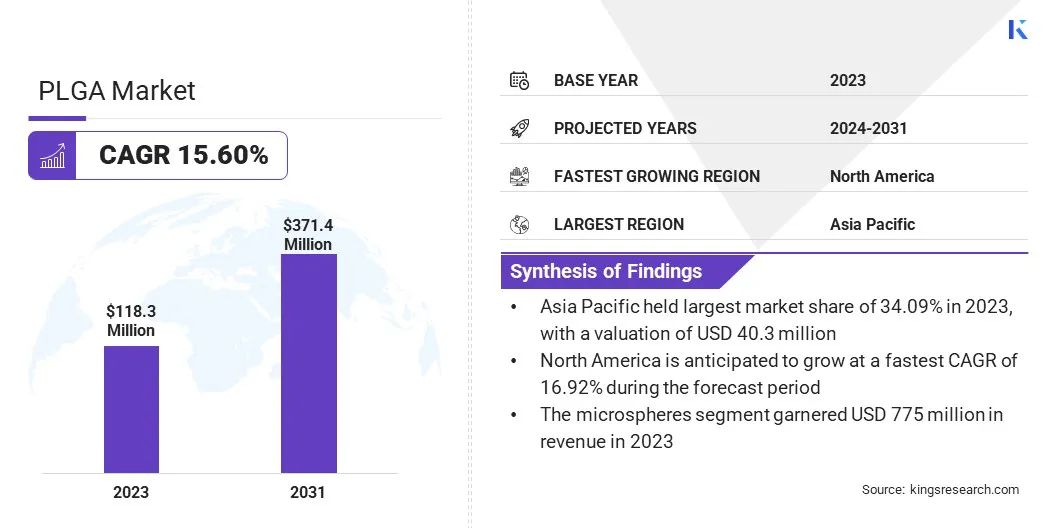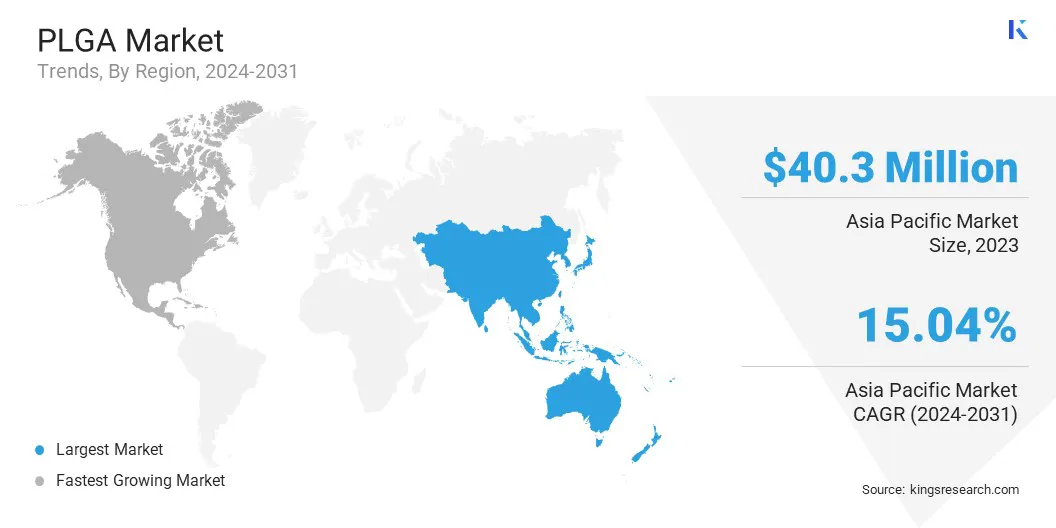Market Definition
PLGA stands for Poly (lactic-co-glycolic acid), a biodegradable and biocompatible polymer. It is widely used in the medical field for delivery of drugs, tissue engineering, and medical implants. Its versatility, biodegradability, and controlled release properties make it ideal for various biomedical applications.
PLGA Market Overview
The global PLGA market size was valued at USD 118.3 million in 2023 and is projected to grow from USD 134.7 million in 2024 to USD 371.4 million by 2031, exhibiting a CAGR of 15.60% during the forecast period.
The market has been registering significant growth, driven by its wide range of applications in the healthcare and pharmaceutical industries. As a biodegradable and biocompatible polymer, PLGA is extensively used in drug delivery systems, tissue engineering, and controlled-release formulations. The rising demand for advanced drug delivery techniques, especially in oncology, vaccines, and gene therapies, fuels the market.
Major companies operating in the global PLGA Industry are Evonik Industries AG, Corbion NV, Ashland Inc., Mitsui Chemicals, Inc., Merck KGaA, Akina Inc, Nomisma Healthcare Pvt. Ltd., Bezwada Biomedical, CD Bioparticles, Polysciences, Inc., Creative PEGWorks, SEQENS, and BMG Inc.
Additionally, PLGA’s applications in the development of medical implants, sutures, and scaffolds for regenerative medicine are further contributing to its market expansion.
Increased Research and Development (R&D) activities in biomedical fields and advancements in polymer synthesis are expected to continue driving the market. Furthermore, the growing trend of sustainable and environment-friendly materials is likely to boost the demand for PLGA as a preferred choice for medical applications.
- In November 2024, Bryn Mawr Communications III, LLC shared a press release that the microspheres are composed of biocompatible materials such as PLGA and gelatin. Designed for minimally invasive treatment, these microspheres can be efficiently injected into wound sites, enhancing patient comfort and accelerating the healing process.

Key Highlights:
- The global PLGA market size was valued at USD 118.3 million in 2023.
- The market is projected to grow at a CAGR of 15.60% from 2024 to 2031.
- Asia Pacific held a market share of 34.09% in 2023, with a valuation of USD 40.3 million.
- The microspheres segment garnered USD 77.5 million in revenue in 2023.
- The 50:50 (PLA:PGA) segment is expected to reach USD 121.7 million by 2031.
- The drug delivery segment is expected to reach USD 126.6 million by 2031.
- The market in North America is anticipated to grow at a CAGR of 16.92% during the forecast period.
Market Driver
"Advancements in Drug Delivery and Sustainable Medical Solutions are Driving the Market"
The PLGA market is driven by the increasing demand for advanced drug delivery systems and the growing emphasis on biodegradable and biocompatible materials in medical applications.
The ability of PLGA to enable controlled and sustained drug release has made it a preferred choice in oncology, gene therapy, and vaccine delivery, as it enhances therapeutic efficacy while minimizing side effects.
Additionally, the rising focus on eco-friendly and biodegradable polymers in the healthcare industry is propelling the market, as PLGA offers a sustainable alternative to conventional synthetic polymers, aligning with global regulatory trends and environmental concerns.
- In December 2024, Silexion Therapeutics Corp. announced its collaboration with Evonik to develop a long-acting siRNA PLGA microparticle formulation for KRAS-mutated cancers. Using Evonik’s RESOMER biodegradable PLGA technology, the formulation has demonstrated high efficacy in preclinical models by enabling sustained-release RNAi therapy.
Market Challenge
"Degradation Variability and High Production Costs as Challenges in the PLGA Market"
The market faces several challenges, including variability in degradation rates and high production costs. The degradation rate of PLGA can fluctuate depending on the ratio of its monomers (lactic acid and glycolic acid) and external factors such as environmental conditions, leading to inconsistent drug release profiles or tissue scaffold performance.
This unpredictability can complicate the development of PLGA-based systems for precise medical applications. Researchers are focusing on fine-tuning the polymer’s composition and enhancing process control techniques to create more uniform degradation rates, allowing for more predictable results in applications like sustained drug delivery and regenerative medicine.
Another significant challenge is the high production cost associated with PLGA, which stems from the complexity of its synthesis and the use of raw materials that may be more expensive compared to conventional polymers.
This makes large-scale production difficult, especially in price-sensitive markets. Thus, manufacturers are investing in efficient manufacturing methods such as continuous production processes, increased automation, and alternative catalysts to reduce costs.
Market Trend
"Advancements in Nanotechnology and Expanding Applications in the PLGA Market"
The market is registering notable trends, including the advancement of nanotechnology in drug delivery and the expansion of PLGA applications beyond pharmaceuticals.
With continuous innovations in nanomedicine, PLGA nanoparticles are being increasingly used for targeted drug delivery and precision medicine, allowing for improved bioavailability and reduced side effects in treatments such as cancer therapy and gene delivery. This trend is growing, due to increasing research in polymer-based nano carriers.
Additionally, the use of PLGA is expanding beyond pharmaceuticals into areas such as medical implants, wound healing and 3D-printed biodegradable scaffolds for regenerative medicine.
As biomedical engineering advances, PLGA’s biocompatibility and tunable degradation properties make it an ideal material for diverse medical applications, further driving the market.
PLGA Market Report Snapshot
|
Segmentation
|
Details
|
|
By Product Form
|
Microspheres, Nanoparticles, Films & Scaffolds
|
|
By Composition
|
50:50 (PLA:PGA), 65:35 (PLA:PGA), 75:25 (PLA:PGA), Others
|
|
By Application
|
Drug Delivery, Tissue Engineering, Medical Devices
|
|
By Region
|
North America: U.S., Canada, Mexico
|
|
Europe: France, UK, Spain, Germany, Italy, Russia, Rest of Europe
|
|
Asia Pacific: China, Japan, India, Australia, ASEAN, South Korea, Rest of Asia Pacific
|
|
Middle East & Africa: Turkey, UAE, Saudi Arabia, South Africa, Rest of Middle East & Africa
|
|
South America: Brazil, Argentina, Rest of South America
|
Market Segmentation:
- By Product Form (Microspheres, Nanoparticles, Films & Scaffolds): The microspheres segment earned USD 77.5 million in 2023, due to their ability to provide controlled and sustained drug release, making them highly effective for targeted therapy.
- By Composition (50:50 (PLA:PGA), 65:35 (PLA:PGA), 75:25 (PLA:PGA), and Others): The 50:50 (PLA:PGA) segment held 37.23% share of the market in 2023, due to its balanced degradation rate and suitability for a wide range of biomedical applications.
- By Application (Drug Delivery, Tissue Engineering, Medical Devices, and Others): The drug delivery segment is projected to reach USD 126.6 million by 2031, owing to the increasing demand for efficient, controlled release systems for chronic disease management and precision medicine.
PLGA Market Regional Analysis
Based on region, the market has been classified into North America, Europe, Asia Pacific, Middle East & Africa, and Latin America.

Asia Pacific accounted for a substantial PLGA market share of 34.09% in 2023, with a valuation of USD 40.3 million. This growth is attributed to the rapidly growing healthcare infrastructure, increasing investments in biotechnology, and the rising demand for advanced drug delivery systems in the region.
Countries like China, India, and Japan are key players in the region, with expanding pharmaceutical industries and research activities in tissue engineering and regenerative medicine. Moreover, the growing population and the prevalence of chronic diseases are driving the demand for PLGA-based medical applications in the region.
The growing emphasis on affordable healthcare solutions further enhances the adoption of cost-effective, biodegradable materials like PLGA in medical devices and drug delivery applications. Additionally, the rise in government initiatives aimed at supporting biotechnology R&D is facilitating advancements in PLGA-based technologies.
The PLGA Industry in North America is expected to register the fastest growth, with a projected CAGR of 16.92% over the forecast period. This growth can be attributed to the high adoption of advanced technologies, strong healthcare infrastructure, and continuous R&D activities in biomedical and pharmaceutical sectors.
The increasing demand for targeted and personalized medicine, along with rising investments in drug delivery systems and tissue engineering, further supports the growth of PLGA-based applications.
The U.S. remains a significant contributor to the market growth, due to its leadership in healthcare innovation, regulatory approvals, and its robust pharmaceutical industry. Additionally, the presence of numerous leading pharmaceutical companies, research institutions, and biotechnology firms in the region is driving the demand for PLGA for clinical and commercial use.
Regulatory Frameworks
- In the U.S., the Food and Drug Administration (FDA) approved the use of PLGA for many biomedical applications, including drug delivery. The FDA has approved many PLGA-based drug products, including injectable and implantable long-acting drug products.
- In Europe, the regulatory authorities responsible for overseeing the use of PLGA in medical applications are the European Medicines Agency (EMA) and the European Commission (EC) under the Medical Device Regulation (MDR) and In Vitro Diagnostic Medical Devices Regulation. The EMA ensures that PLGA-containing products meet strict safety, efficacy, and quality standards before they are approved for clinical use.
- In China, the regulatory authority overseeing the use of PLGA is the National Medical Products Administration (NMPA), which is responsible for regulating both drugs and medical devices within the country.
- In Japan, the Pharmaceuticals and Medical Devices Agency (PMDA), under the Ministry of Health, Labour and Welfare (MHLW), regulates PLGA-based medical products in accordance with the Pharmaceutical and Medical Device Act. The PMDA conducts rigorous evaluations on the safety, effectiveness, and biodegradability of PLGA formulations before granting market approval.
Competitive Landscape:
The global PLGA market is characterized by various participants, including established corporations and rising organizations. Key market participants focus on continuous innovation, strategic partnerships, and expanding their product portfolios to maintain a competitive edge.
Companies are investing heavily in R&D to improve the functionality and performance of PLGA-based products, targeting diverse applications in drug delivery, tissue engineering, and medical devices.
Additionally, collaborations between biotechnology firms, pharmaceutical companies, and research institutions are helping accelerate the development of novel PLGA formulations with enhanced properties, such as controlled degradation rates and increased biocompatibility.
Geographic expansion, regulatory compliance, and partnerships with research institutions & biotechnology firms also play an important role in shaping the market's dynamics.
- In November 2024, Avantium N.V. and SCG Chemicals announced a multi-year collaboration to pilot PLGA production from CO₂ feedstock using Avantium’s Volta Technology. The partnership aims to develop sustainable PLGA polyester as an alternative to fossil-based materials, with SCGC supporting technology development and application exploration.
List of Key Companies in PLGA Market:
- Evonik Industries AG
- Corbion NV
- Ashland Inc.
- Mitsui Chemicals, Inc.
- Merck KGaA
- Akina Inc
- Nomisma Healthcare Pvt. Ltd.
- Bezwada Biomedical
- CD Bioparticles
- Polysciences, Inc.
- Creative PEGWorks
- SEQENS
- BMG Inc.


